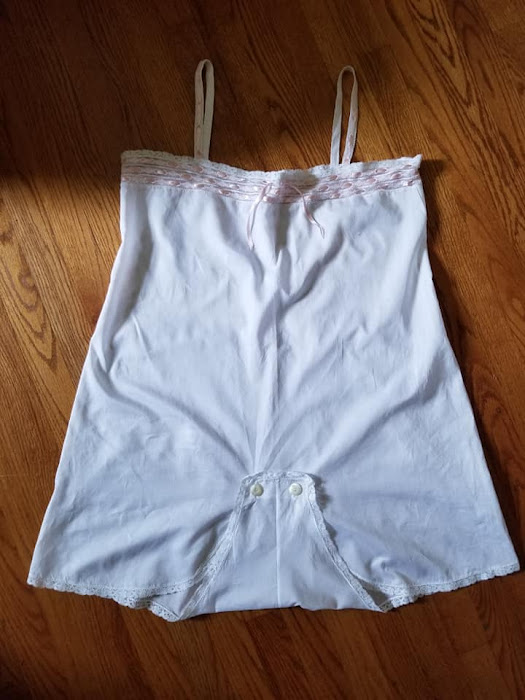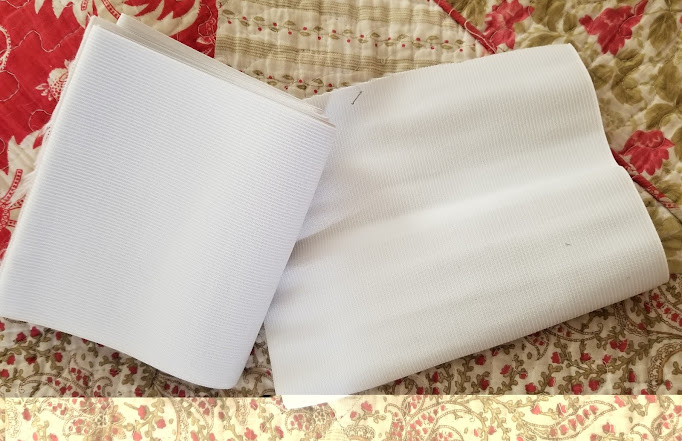After engaging in a fair amount of research into 1920s underpinnings, I decided to get down to making mine. Some people can just get away with a teddy or tap pants and a simple bandeau bra. I'm NOT one of those people. I have curves which are definitely not a 1920s silhouette. My research revealed a wide variety of corset styles that evolved through the decade as you can see in this post. I knew that I'd need a chemise and some sort of corset. 1920s corsets tended to be under bust corsets so I also needed something up top to flatten my chest.
Since I work from the skin out, I started with my envelope chemise. I found this reprint of a 20s pattern that came in one size--bust 36--which happened to fit. I traced the pattern using pattern tracing cloth on the fold for the front and 2 pieces for the back, pinning the seams together to fit it. Perfect fit except the torso was too long. I took a 1 inch tuck to shorten the body 2 inches for a perfect fit. I chose to make the view with the straps.
I used Nelona Swiss batiste and French valenciennes lace. The trim at the top is 3 rows of lace beading stitched together with a narrow lace edging. The straps are made of the same lace beading stitched to cotton twill tape for durability. The ribbon is pink double sided satin. I added the same lace edging to the bottom edge and used 2 antique mother of pearl buttons for the closure.
I thought a corselette would be a good way to achieve the straight silhouette. I found 2 downloadable patterns that were similar to period garments I had seen. I have to admit that in the back of my mind, I had my doubts about this type of garment given my body shape.
I decided on the Reconstructing History pattern because I liked that it had elastic inserts. I was able to find 8 inch wide elastic which was still not wide enough.
I experimented with zigzag stitching two pieces together and that worked so I was in business.
I have read for years that Reconstructing History patterns have horrendous fitting issues. I took my body measurements and followed the measurements listed in the pattern sizing and made adjustments to the pattern pieces before tracing them off. For some reason, I didn't flat measure the pattern pieces. This is something I typically do. I made a fitting muslin out of heavy denim and was stunned to find the pattern to be about 6 inches too small around--something that flat measuring would've revealed. That's a ridiculous amount given that I followed the body measurements listed in the pattern. I ripped the muslin apart and cut new side pieces with a new pattern piece that had 3 inches added to the center of it. That worked.
I constructed the corselette as indicated, using satin bias tape on the edges and adding an underlap to the closure. I also covered the seams with tape for a cleaner finish.
Back
Closure--hook side
Front
Back
The bust is flattened sufficiently so it would seem that a brassiere made from a firm fabric would have the same effect.
Next I needed a slip. I chose to use silk crepe de chine which seems to have been a common textile used for slips based on ads I've studied. I found this pattern for sale on Etsy but didn't buy it. The pics reveal that it is nothing more than a one hour dress shape in the body.

I had already drafted a one hour dress so I took my chemise pattern and laid it over the dress pattern, tracing the shape of the neckline/straps.
I made the slip up which was pretty basic. Side seams then a facing on the slashed area that overlaps the side pleats. The neckline was finished with a row of French beading with a narrow edging. The edging was also applied to the armholes.

Plan B:
Make a brassiere and corset which was my original plan. I found this brassiere in my 1922 catalog that I like. It's simple and has a front closure. There is an elastic insert in the back. It is made from "lightweight but firm cotton tricot mesh" which seems to have no modern equivalent. It also appears to have boning at the side seams. I noted other brassieres that were made out of cambric--almost like Edwardian corset covers.
I had bought this pattern by Wearing History that came in one size (38). I took my measurements and adjusted the pattern accordingly to fit. I cut it out with an opening at the center front with a 1/2 inch turn under. I cut the back with a seam allowance added to the center back. I figured I'd just fit it as I went since I was just using some polished cotton.
I seamed the center back and sewed the darts and found that it fit perfectly. I cut a 4 inch wide piece of my 8 inch wide elastic and cut away 3 inches from the center back, turning under 1/2 inch and stitching the cotton over the elastic. I turned under the hems at the top and bottom The bottom hem had to be increased as the brassiere was a little too long. I used twill tape to face the hems then turned under and pressed the front edges.
I trimmed away the dart and decided to cover it with 3/4 inch boning channel.
Boning channel was stitched in and German artificial whale bone was added. The hook and eye tape was added.
I added lace beading and ribbon to the top and bottom and made straps like those on my chemise--lace beading stitched to twill tape.
Front:
Back:
I'm happy with this piece. I would like to make one that's a bit heavier--perhaps out of coutil.
Next the corset--I don't have time to get to this one right now. I had found this extant one for sale with about a dozen pics so I feel I can reproduce it. It's really the shape I would prefer. I'm torn between ripping apart the corselette and using that same coutil or using the fabric I have left. I need to draft this from a well fitted corset pattern. I bought the Scroop late Edwardian corset which will have the right shape so I will need to fit it, move seam lines etc. That is my long term goal. This one has a hook and eye closure on the side front and lacing in the back. I'm always more comfortable in a well fitted boned garment.
What to do in the meantime? Well they did have garter belts. I need something to hold up my stockings.
I decided to go with a plain modern garter belt in the meantime. Not exactly accurate but close enough to do what I need it to do.
Let's see how this works.
This is way more comfortable.
Here's the slip which is very comfortable.
Chest flattening is fine as can be seen here.
Conclusion: This will be a challenging era for me to achieve the "correct" silhouette. I think my original plan of a boned corset will be better for my body type. Worn with the flattening brassiere, it should give me as close of a 20s silhouette as I'm going to get. Plus the open bottom girdle styling was also popular in the 1930s and I can use the same garment for that era.











































Just ran across this, very cool! Hope you got it worked out the way you wanted.
ReplyDelete